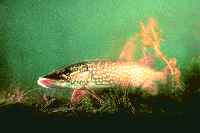| | Fisheries Act | Pest Control Products Act
The two major acts relating to environmental impacts from cropping operations are the Fisheries Act and the Pest Control Products Act.
Fisheries Act
Deleterious substance
The Fisheries Act prohibits anyone from depositing or permitting the deposit of anything into any type of water frequented by fish, which can have a "deleterious" or harmful effect on the fish. Further, the Act prohibits anybody from depositing a "deleterious" or harmful substance in any place under any condition where the substance may enter any water frequented by fish. The Act defines the phrase, "water frequented by fish" very broadly to include all internal waters of Canada. This definition includes any creek, river, stream, lake or slough frequented by fish, including a creek that has minnows in the spring, but dries up later in the summer.

Fish habitat is protected by the federal Fisheries Act.
Courtesy of ARD
As an example, an operator commits an offence under the Act if he spreads manure on land near a stream frequented by fish and the manure gets into the stream in sufficient quantities to have a "deleterious effect." The offence results even if the manure does not actually cause harm to the fish. The mere fact that the manure reached water frequented by fish is an offence and may result in charges under this Act, unless the operator can prove that at all times, the water is not, has not been, and is not likely to be frequented by fish.
In addition, an operator risks committing an offence if he spreads manure on land near a stream frequented by fish, even if the manure does not in fact enter the water, but had a reasonable chance of entering the water. However, if the operator can prove that at all times, the water is not, has not been and is not likely to be frequented by fish, then the operator has not committed an offence under the Act.
Harmful alteration, disruption or destruction of fish habitat
The Fisheries Act prohibits the carrying on of any work or undertaking that results in "harmful alteration, disruption or destruction" of fish habitat, although an authorization can be obtained from the Department of Fisheries and Oceans allowing such an activity. As noted above, fish habitat is defined quite broadly in the Act. These provisions may come into play in situations in which an operator would also require approval under Alberta's Water Act for a water management project.
Liability of directors and officers
If a corporation violates the Act, any officer, director or agent of the corporation who was involved with the incident, even in a minor way, is liable on conviction to punishment under the Act, whether or not the corporation itself has been charged. This is true regardless of whether the officer, director or agent works for a large corporation or a small incorporated family farm. This means an officer, director, agent or a incorporated farm can by held personally responsible for violations of the Act, if the officer or director directed or participated in the violation.
Strict liability offences
Offences under the Fisheries Act regarding the deposit of deleterious substances or harmful substances into water frequented by fish are strict liability offences. The courts are only concerned with whether the operator committed the offence, and not whether he or she intended to commit the offence or the morality of the actions.
If the operator did commit the "deleterious substance" action, the courts will convict the operator unless the operator can show that:
- at all times, the water is not, has not been and is not likely to be frequented by fish;
- the operator acted with due diligence to prevent the commission of the activity at issue; or
- the operator reasonably and honestly believed in the existence of the facts that, if true, the operator's conduct would be rendered innocent.
Fines
An individual or incorporated farm is liable to a fine not exceeding $1,000,000 for the operator's first deleterious substance offence and to a fine not exceeding $1,000,000 or to imprisonment for a term of not exceeding three years or to both for any subsequent deleterious substance offence.
Pest Control Products Act
The Pest Control Products Act specifies the responsibilities of the federal Pest Management Regulatory Agency (PMRA) for registration of pesticides for use in Canada.
- In terms of user responsibility, as stated on the product label, anyone using a pest control product has the responsibility to read the label and follow the directions including the following:
- before purchasing a pesticide, to determine if the product will control the pest problem and if it can be applied in a safe manner.
- before mixing the pesticide with other products or additives, to ensure product compatibility.
- before spraying, to determine the required precautions during spraying, and to follow those precautions.
Back to Chapter 9 - Legislation |
|